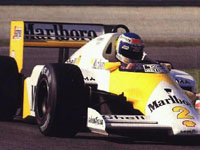Camera! Marlboro Lights! Action!
Author
- Mattijs Diepraam
Date
- 8W January 1999 issue
Related articles
- 1978 International Trophy - Keke's miracle win, by Mattijs Diepraam
- 1983 South African GP - Honda power moves Williams back up the grid, by Leif Snellman
Who?Keke Rosberg What?McLaren-TAG Porsche MP4/2C Where?Estoril When?1986 Portuguese GP |
 |
Why?
In the rules package the FIA introduced for the new millennium there was a spur-of-the-moment rule that by all means stood out as the silliest of them all: the outlawing of different liveries on cars of the same outfit. It certainly captured everyone's attention when the upstarts at British American Racing sued the governing body over its inpromptu measures aimed solely and directly at the new entrant - or at least that was the rule's suspected purpose, according to BAR, a view that was backed up by many F1 pundits.
Modern F1 history shows BAR had a point. Rosberg's Marlboro Lights McLaren at Estoril '86 is just one of the examples of separate liveries. The gold livery was used to satisfy Philip Morris's curiosity concerning the looks of such a colour scheme on television. Apparently it was no great success, since it was the only time the car ever ran in those colours.
At Suzuka 1993, Martin Brundle tried out a different colour scheme for Ligier's Gitanes sponsorship, while Tyrrell used distinctly different liveries in the season the FIA took away its points (1984): Brundle (him again) sported DeLonghi decals on a mainly purple-coloured car, Stefan Bellof drove a black Maredo-sponsored 012.
Another lovely example is Shadow's split effort in 1979 - especially because of the roaring Samson lion on the nose of Jan Lammers' DN9, with De Angelis' Interscope version looking distinctly bland compared to its sister car.
The Surtees team had different sponsors on its cars during 1976-'78, Durex funding the first car for the likes of Alan Jones, Binder, Schuppan and Leoni, while Brett Lunger brought Chesterfield and Campari sponsorship to the team's second car in 1976, with Vittorio Brambilla taking his Beta money to Surtees in 1977 and 1978.
The most striking example was of course set by the multi-car effort March fielded in 1976. It had Brambilla in the No.9 Beta car, Lella Lombardi and then Ronnie Peterson drove the No.10 March, sponsored by Lavazza and First National amongst others, while Hans-Joachim Stuck was entered in the orange No.34 Jägermeister car, with Arturo Merzario racing until half-season in a fourth Ovoro entry. To top it off, Peterson's car changed appearances about every race, the team lining up separate supporting sponsorship deals in the art world - a business you would not normally associate with F1.
In 1977, its last season as March Engineering, the team continued the theme, fielding a Rothmans car for Ian Scheckter and a Hollywood car for Alex Ribeiro. The man responsible for the novel idea? Today's FIA president Max Mosley...
